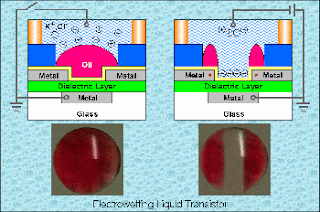UC Engineering Research Widens Possibilities for Electronic Devices, NSF-funded engineering research on microfluidics at the University of Cincinnati widens the possibilities on the horizon for electronic devices.
 | Parting a tiny red sea at the University of Cincinnati: Today’s — and tomorrow’s — sophisticated electronic devices may hinge on our ability to control microdrops of liquid on a surface. |
As recently published in Applied Physics Letters and featured on the cover of the journal, Andrew Steckl’s research on liquid-state-field-effect transistors (LiquiFETs) promises improvements in such things as “lab on a chip” devices. These tiny devices, reminiscent of the “Fantastic Voyage,” can be introduced into the blood stream to monitor the blood’s chemistry. Steckl, a professor in the Department of Electrical and Computer Engineering in the College of Engineering, calls it “liquid logic” — using liquids to make electronic devices instead of solids.
One of the limitations of traditional health care instruments, for example, is that the information contained in the liquid (blood, in this example) must be translated into electrical signals that can be read in some kind of measuring device. Classical methods for this “translation” have used methods based on light and colorimetric measurement, direct optical sensing (using a video camera or detector) or combinations of optical excitation of fluorescent dyes.
This technology could have applications in biology, health sciences and many other areas.
“In microelectronics, we usually think small,” says Steckl. “But there are applications where you have to think large — like big, big flat-panel televisions, with flexible panels perhaps.” Other applications might be for objects that have a peculiar shape, like the curves and corners of an automobile.
“Biomedical applications are also a natural,” Steckl continues. “Biomedical devices are both analytical — where they take measurements — and therapeutic — where they deliver treatment.” Analytical measurements need to be done in vitro (in glass, meaning in a test tube or other vessel) or in vivo (meaning in the body). Researchers are constantly striving for ways to optimize drug delivery to the patient. Devices perform many functions in drug delivery to measure the existing condition and to measure the effect of the medicine, for example. The doctor checks the condition after drug delivery, perhaps adjusts the dose, sees the effect and monitors the patient’s reaction.
“More research is needed, but perhaps the same device could be used for both analytical and therapeutic purposes,” says Steckl. “With these devices, you have a real-time evaluation of effectiveness and a real-time adjustment of the dose. The faster that the doctor can know the effects of the drug, the better.” More information on this research is available at the Web site for Steckl’s lab at UC.
UC is rapidly becoming a hot bed for research on electrowetting and more generally in microfluidics. For example, Steckl and his colleague Jason Heikenfeld have collaborated on electrowetting light valves and related applications. Many colleagues in UC’s electrical engineering, mechanical engineering, chemistry and other disciplines are also heavily involved in microfluidics research.
The research on LiquiFETs was made possible through funding by a program at the National Science Foundation called “SGER”: Small Grants for Exploratory Research. Proposals for small-scale, exploratory, and high-risk research in the fields of science, engineering and education normally supported by NSF may be submitted to individual programs. Such research is characterized as preliminary work on untested and novel ideas; ventures into emerging research ideas; the application of new expertise or new approaches to “established” research topics; having extreme urgency with regard to availability of or access to data, facilities or specialized equipment, including quick-response research on natural disasters and similar unanticipated events; and efforts of similar character likely to catalyze rapid and innovative advances.
Yin and yang: Here you see Professor Steckl’s use of electronic devices in biological materials. Next, learn about Professor Steckl’s use of biological materials in electronic devices.
University of Cincinnati Date: 4/2/2007 By: Wendy Beckman Phone: (513) 556-1826, More UC News UC Home
Technorati Tags: nanofibers or Nanoscientists and Nano or Nanotechnology and nanoparticles or Nanotech and nanotubes or nanochemistry and nanoscale or nanowires and Nanocantilevers or nanometrology and liquid state field effect transistors or Fantastic Voyage and microfluidics or University of Cincinnati















No comments:
Post a Comment